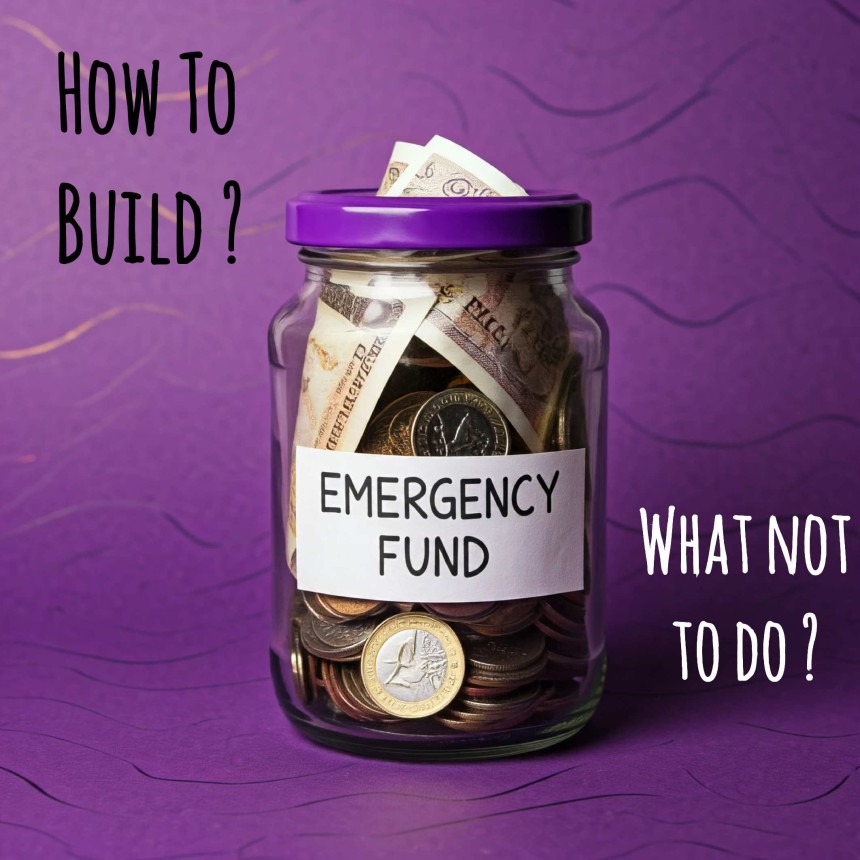
Emergency Fund: Planning & Modern Approach
All of us understand the meaning of the word "emergency," but if we look it up in the dictionary, it defines an emergency as "a serious, unexpected, and often dangerous situation that requires immediate action." There are four key aspects here: it is serious, unexpected, often dangerous, and requires immediate action.
1. Why ?
Let me give you two examples :
- First, suppose tomorrow my company decides to lay off 200 employees, and I am one of them. This is a serious situation—unexpected, potentially dangerous, and needing immediate action.
- Second, imagine I'm driving and get into an accident. This too is serious, unexpected, dangerous, and requires immediate action.
My point is simple: emergencies can come in any form, at any time. They can happen to you or to me—none of us are immune. While we cannot prevent emergency situations, what we can do is prepare by building an emergency fund. This fund will act as our best friend in times of crisis. It won't eliminate the emergency, but it will reduce its impact, turning a potential disaster into a mere inconvenience.
So, it's essential for all of us to have an emergency fund for future security.
2. How Much Money to Save

How much money do you need to save for emergency situations, also known as an emergency fund? Here's a simple rule of thumb that you can follow:
- If you are a single income earner with no dependents—meaning you don’t have a spouse, children, or financially dependent parents—then multiply your average monthly expenditure by six. So, six months' worth of your monthly expenses is a good target for your emergency fund.
- If you have up to two dependents, then use a factor of 12—multiply your monthly expenses by 12. If you have three to four dependents, multiply your monthly expenditure by 18. This will give you a sufficient emergency fund for proper planning.
- If you are in a dual-income household—for example, both you and your spouse are working—then the rule changes slightly. If you have no dependents, three months of expenses should be enough for an emergency fund. If you have up to two dependents, aim for six months of expenses. And if you have three to four dependents, aim for nine months of your monthly expenses as your emergency fund.
A quick clarification: when I say "dependents," I’m referring to people who are financially dependent on you. For instance, if your parents are still earning, even though they might be emotionally or physically dependent on you, they are not considered financially dependent.
For example, if your monthly expenditure is ₹50,000, and you are a single earner with two dependents, your emergency fund should be ₹50,000 multiplied by 12, which equals ₹6 lakh. So, you should plan to build an emergency fund of ₹6 lakh.
3. How to Start Building an Emergency Fund

Six lakhs is not a small amount, and you can’t just create it overnight. The answer is simple: start building it month by month. For example, if you can save ₹20,000 per month and set it aside for your emergency fund, that’s great. It will take you about two and a half years to build the entire ₹6 lakh, but believe me, it is a completely worthwhile exercise.
Now, you might have a few questions. You may say, "I’m already investing ₹20,000 per month in SIPs, so I don’t have any extra money to build an emergency fund. What should I do?" My simple answer is: please pause your investments for the next two and a half years and direct that money towards your emergency fund. This is a priority.
Another question you might have is, "I own a property worth ₹50 lakh. Can I consider that as my emergency fund?" My simple answer is no. Property is not a suitable emergency fund because you cannot liquidate it instantly when you need cash.
You might also ask, "I’ve already invested in a good index mutual fund. Can I count that as my emergency fund?" Again, the answer is no. You won’t be able to withdraw that money immediately; it will take at least two to three days to get the funds. Also, keep in mind that if your emergency happens during a downturn in the market, like during the COVID crisis, your investments might not be worth the full ₹6 lakh when you need them, as stock markets are highly volatile. The value of your emergency fund could decrease due to various market conditions.
An emergency fund needs to be readily accessible and stable, so investments tied to market volatility or assets like property are not appropriate substitutes.
4. Where to Invest Emergency Fund

Where should you actually park your money when it comes to an emergency fund? My advice is to choose an asset class that fulfills three key criteria:
- Safety: Your money must be 100% safe. Remember, this fund is for emergencies, and you need to ensure that the money is there when you need it, without risk of loss.
- Liquidity: You should be able to withdraw the money quickly—ideally, within 24 hours. The quicker you can access the money, the better.
- Returns that match inflation: At the very least, the fund should generate returns that keep up with inflation. You don’t want inflation to erode the value of your emergency fund over time. For example, if you need the money 10 years from now, you don’t want your ₹6 lakh to only be worth ₹3-4 lakh in real terms.
In my view, two categories fulfill these conditions: Fixed Deposits (FDs) and Liquid Mutual Funds.
Most of you are familiar with fixed deposits. As for liquid mutual funds. Liquid mutual funds are debt instruments that invest in securities maturing within 91 days, making them very safe. The debt is issued to the government, banks, or highly-rated companies, so the risk of default is extremely low.
There are no exit loads or lock-in periods with liquid mutual funds, meaning you can withdraw your money quickly—typically within one working day. In fact, some liquid funds allow you to withdraw up to ₹50,000 within 30 minutes, which is faster than you could get money from a fixed deposit.
You might be wondering why I recommend both fixed deposits and liquid mutual funds. The reason is that returns fluctuate. Some years, fixed deposits give better returns, while in other years, liquid funds perform better. For example, in 2020-2021, liquid funds offered around 3% annual returns, while fixed deposits provided 4-5%. However, back in 2014, liquid funds were offering 9-10% returns, compared to 8-9% for fixed deposits. Given these variations, it’s a good idea to diversify between the two.
Now, the question is: How should you split your money between these two options? My recommendation is to allocate 50% to fixed deposits and 50% to liquid mutual funds.
For example, if you’re building a ₹6 lakh emergency fund, put ₹3 lakh into fixed deposits. To maximize flexibility, break this into multiple smaller FDs—say, three FDs of ₹1 lakh each—so that you don’t have to withdraw the full amount in one go and face penalties or tax liabilities.
Similarly, put the remaining ₹3 lakh into liquid mutual funds. Choose two or three different funds and split your money evenly between them. This will allow you to withdraw ₹50,000 from each fund if needed. So, in an emergency, you could access ₹1.5 lakh within 30 minutes, which is what truly matters.
By using this approach, you ensure that your emergency fund is safe, accessible, and able to keep pace with inflation.
5. Important points

Now I want to discuss three very important points regarding emergency funds with you.
- Review and Top Up Regularly: Make sure to review your emergency fund every two years and top it up if your expenses have increased, which they likely will. What you don’t want is to set up your emergency fund once and then forget about it. Since our expenses typically rise over time, it’s important to adjust your emergency fund accordingly at least every two years.
- Restore the Fund After Use: If you ever need to use your emergency fund—hopefully not, but emergencies do happen—make sure to restore it afterward. An emergency fund isn’t something you use once and forget about. After you use it, you must replenish it to ensure you're prepared for future emergencies. This is critical.
- Use It Only for Emergencies: It's tempting to dip into your emergency fund for other things, but it’s crucial to resist. You need to think of this money as not belonging to you—it belongs to the future emergency that may arise. Only use it for real emergencies.
These three points are key to ensuring that your emergency fund remains effective and serves its purpose.
________________________________________________________Thank you !





